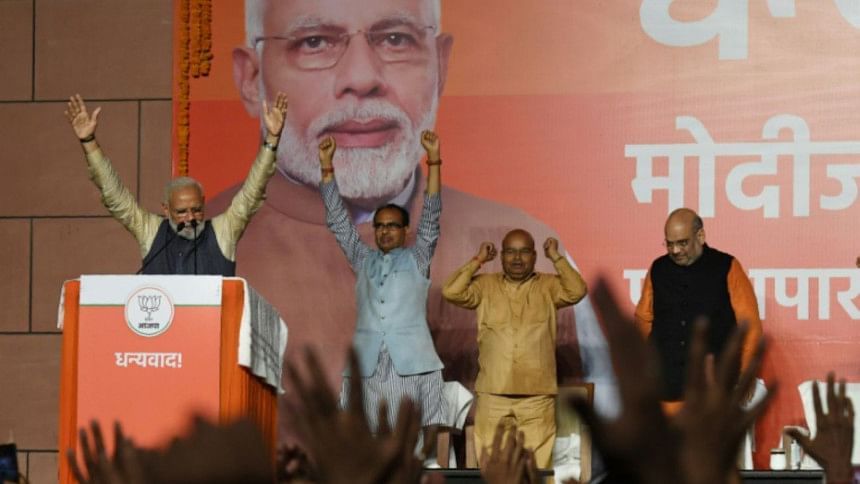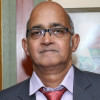BJP’s election victory: Of Modi, by Modi and for Modi

The biggest take-away from the Indian elections is that the scale and sweep of the BJP's victory across 22 states of the country, including West Bengal, smashed the traditional caste, class and ethnic fault lines in areas where these factors have traditionally mattered most—Uttar Pradesh and Bihar—which together account for 120 parliamentary seats. Clearly, Modi's chemistry turned the caste arithmetic on its head which saw the BJP increasing its vote-share and tally of seats significantly from the previous national poll in 2014 to this year's general election. The 2019 national election mandate thus signified a fundamental shift in Indian politics which has the potential to make traditional caste loyalties irrelevant before the developmental narrative. No wonder, Modi, in his victory speech at the BJP national headquarters in New Delhi, said "that there are only jaatis (castes) in India today—one is that of the poor and the other is made up of those who want to contribute to take people out of poverty. There is no other caste."
At pan-India level, it was a contest between the BJP-led National Democratic Alliance and the United Progressive Alliance led by the Congress President Rahul Gandhi. But the fight took different shapes in different states where the BJP was confronted by a range of regional parties like Samajwadi Party-Bahujan Samaj Party-Rashtriya Lok Dal alliance in Uttar Pradesh, Janata Dal (S) in Karnataka, Biju Janata Dal in Odisha, Telugu Desam Party in Andhra Pradesh and Trinamool Congress in West Bengal. Barring Karnataka, the Congress too was pitted against these regional outfits apart from facing the BJP.
In his campaign speeches, Modi sought the mandate on the basis of the report card of his government in the last five years, including economic and foreign policy agenda, social welfare schemes for rural areas like electricity, cooking gas cylinders and toilets which went down well with the people, particularly women who voted in large numbers almost matching men. But livelihood issues alone do not win elections in India. Therefore, the BJP blended these issues with national security and emotive Hindutva planks using the Indian air strikes on a terror camp in Pakistan in February and the Citizenship Amendment Bill.
Modi completely overshadowed his party in the election and in the process stream-rolled almost the entire opposition. In whichever part of India one went to, the one common and oft-repeated refrain that was heard was Modi. His supporters and critics hardly mentioned the BJP but spoke about the 68-year-old prime minister. It was not just Modi versus the opposition in the electoral battle. But Modi was projected as the panacea for all the anti-incumbency issues the BJP faced. Whenever each and every candidate of the party faced voters' discontent in their constituencies, they took shelter behind Modi. This was a phenomenon not witnessed since Indira Gandhi at the height of her popularity immediately after the liberation of Bangladesh. The BJP succeeded in pitching the national election as a presidential-style campaign and dared the opposition to name its prime ministerial face. While Modi was the known PM face of the NDA, Rahul Gandhi was never projected so by the UPA due to reservations against his leadership among some regional parties like the Trinamool.
The opposition remained fragmented and failed to put up an overarching pan-India united face against the BJP because it was not possible and because the Congress was not interested in it as the party itself was in a turf war with many of the regional parties in states like in Andhra Pradesh, Telangana, Odisha and West Bengal. The so-called anti-BJP unity efforts did not find acceptability and credibility to voters. Since the Congress and regional parties fought against each other in most states, they ended up splitting anti-BJP votes to the advantage of the BJP.
The Modi magic not only propelled the BJP to retain what it had won in the 2014 parliamentary election—like the electorally key states of Uttar Pradesh, Maharashtra, Madhya Pradesh, Rajasthan, Chhattisgarh, Bihar and Delhi—but actually conquer new areas in Karnataka and a big state like West Bengal where it emerged as the main challenger to Chief Minister Mamata Banerjee's Trinamool Congress not only in terms of seats, but also vote share. In all these states, Modi's persona successfully trumped over the caste cleavages which were used by parties like Samajwadi Party and Bahujan Samaj Party over the years. However, the BJP failed to make any impact in southern states barring Karnataka.
The SP-BSP was thought to be a formidable caste coalition in Uttar Pradesh but it crashed against the Modi factor which weighed so heavily on key regional parties like Biju Janata Dal in Odisha and Trinamool Congress. It is the Modi factor which was largely behind the SP and the BSP joining hands for survival after their decimation in the 2014 polls and 2017 assembly elections in UP on the assumption that the two parties can help overcome years of rivalry and transfer the votes of their traditional support base to each other's kitty. But that has not happened to the extent the SP and the BSP wanted. This may force a fresh realignment of forces in the state's politics. The Akhilesh Yadav-Mayawati alliance roped in Ajit Singh's Rashtriya Lok Dal assessing that the Jat vote in western UP would desert the BJP which did not materialise. The BJP retained its own support base among non-Jatav (the caste of Mayawati) and non-Yadav (the caste of Akhilesh Yadav) castes but the SP-BSP coalition triggered a consolidation of other castes behind the BJP.
Another important factor in the BJP's victory was the sustained campaign Modi successfully wove on national security after the Pulwama terror attack, India's air strike on a terror camp in Balakot, Pakistan, and Hindutva by assuring Bengali-speaking Hindus of Assam and West Bengal that they stand to benefit from the controversial Citizenship Amendment Bill as Trinamool Congress increasingly pushed for consolidation of 30 percent Muslim voters in West Bengal. The Balakot strike projected Modi as a strong and decisive leader who declared Indian security forces would enter the home of every terrorist and defeat them. The narrative of nationalism struck a popular chord and squeezed much of the opposition, particularly those who sought to question the veracity of Balakot strike, out of political space.
The opposition, particularly the Congress and the Trinamool Congress, made the grave error in launching a no-hold barred sustained negative campaign against Modi accusing him of corruption in the Rafael fighter jet purchase deal with France. As long as Rahul Gandhi had focused on alleged irregularities in the deal, he could create a perception that there is something amiss in the deal. But the moment he brought the prime minister into his firing line by coining slogans like "chowkidar chor hai", his offensive fell apart for none was willing to buy any graft charge against Modi given the latter's impeccable integrity.
Mamata Banerjee's vituperative outbursts against Modi and her refusal to take phone calls twice from the prime minister who wanted to speak to her on possible assistance to the state from the Centre to cope with cyclone "Foni" did not go down well with the people. Modi's restrained and jocular response to Mamata's vitriol stood out in sharp contrast—as for example, when he said in a public meeting in West Bengal that "Didi your slap (of democracy) would be a blessing for me." In fact, the negative campaign against Modi boomeranged badly against both the Congress and the Trinamool Congress. Modi's political success lies in that he forced the opposition into making this mistake which turned what would have a clash of ideologies into a personalised battle.
Pallab Bhattacharya is a special correspondent at The Daily Star.

 For all latest news, follow The Daily Star's Google News channel.
For all latest news, follow The Daily Star's Google News channel. 



Comments